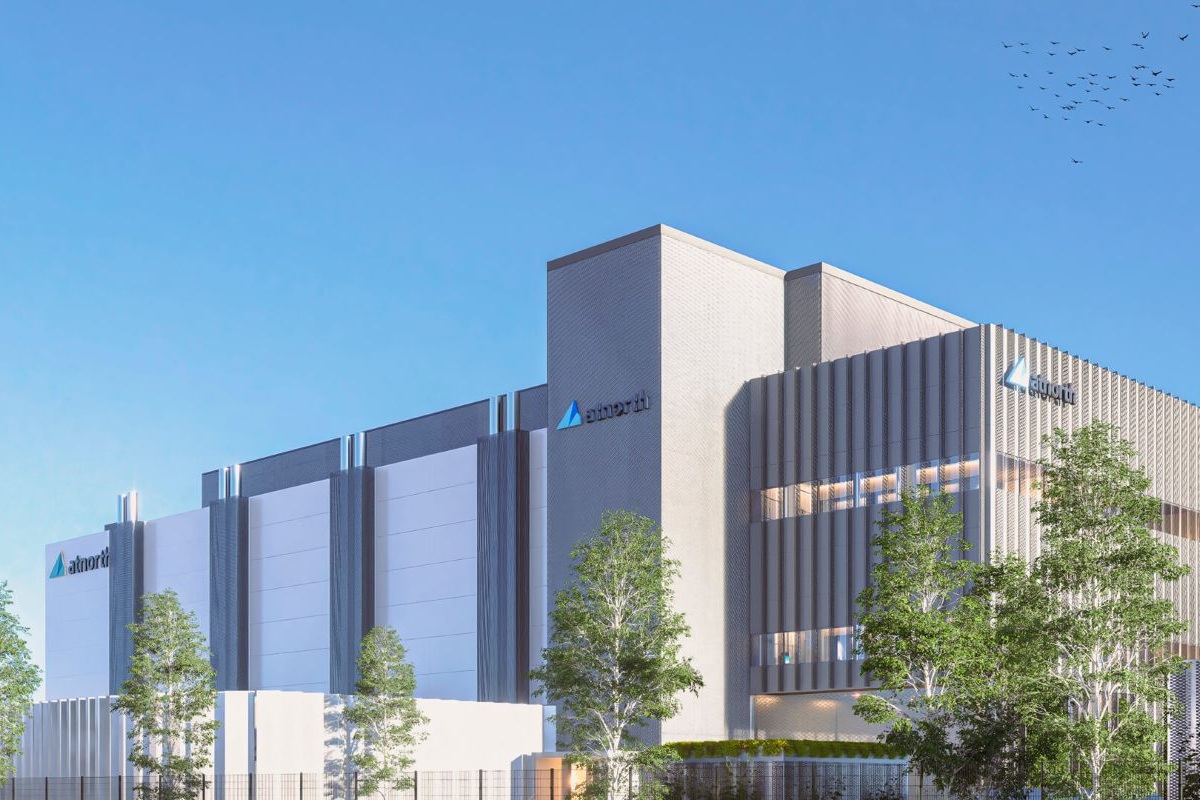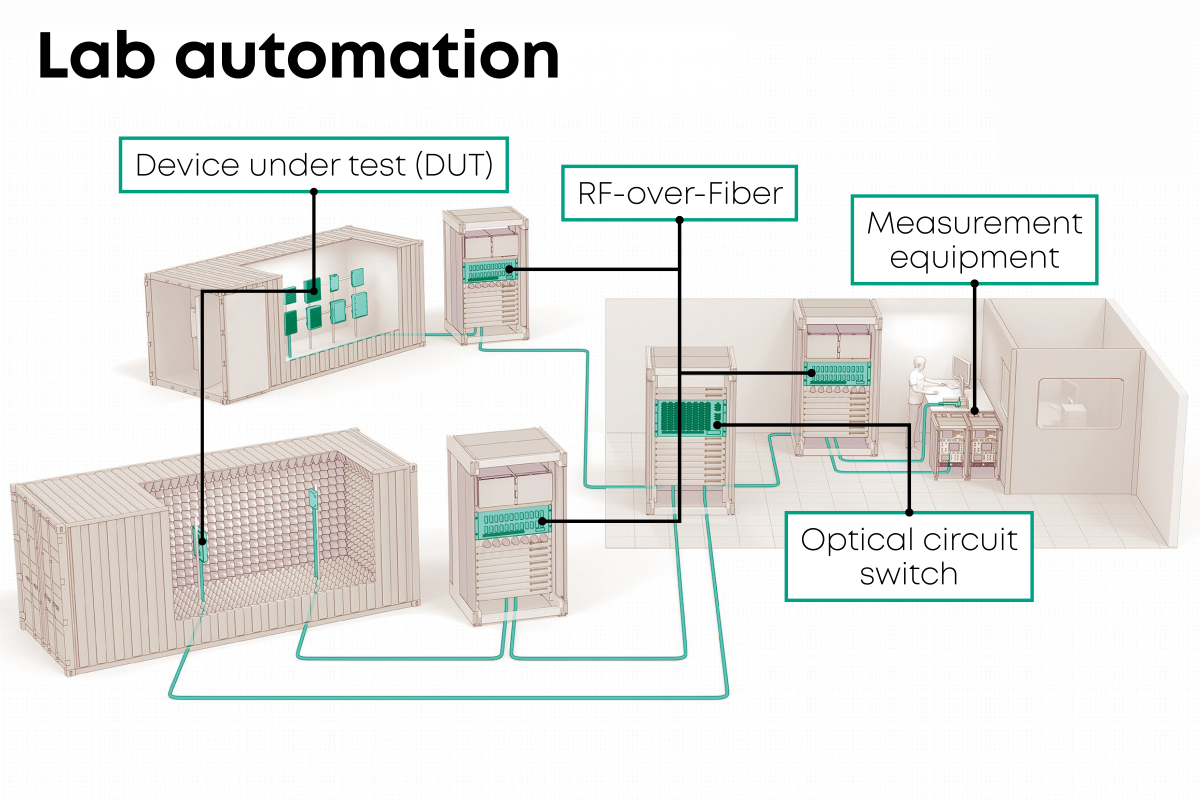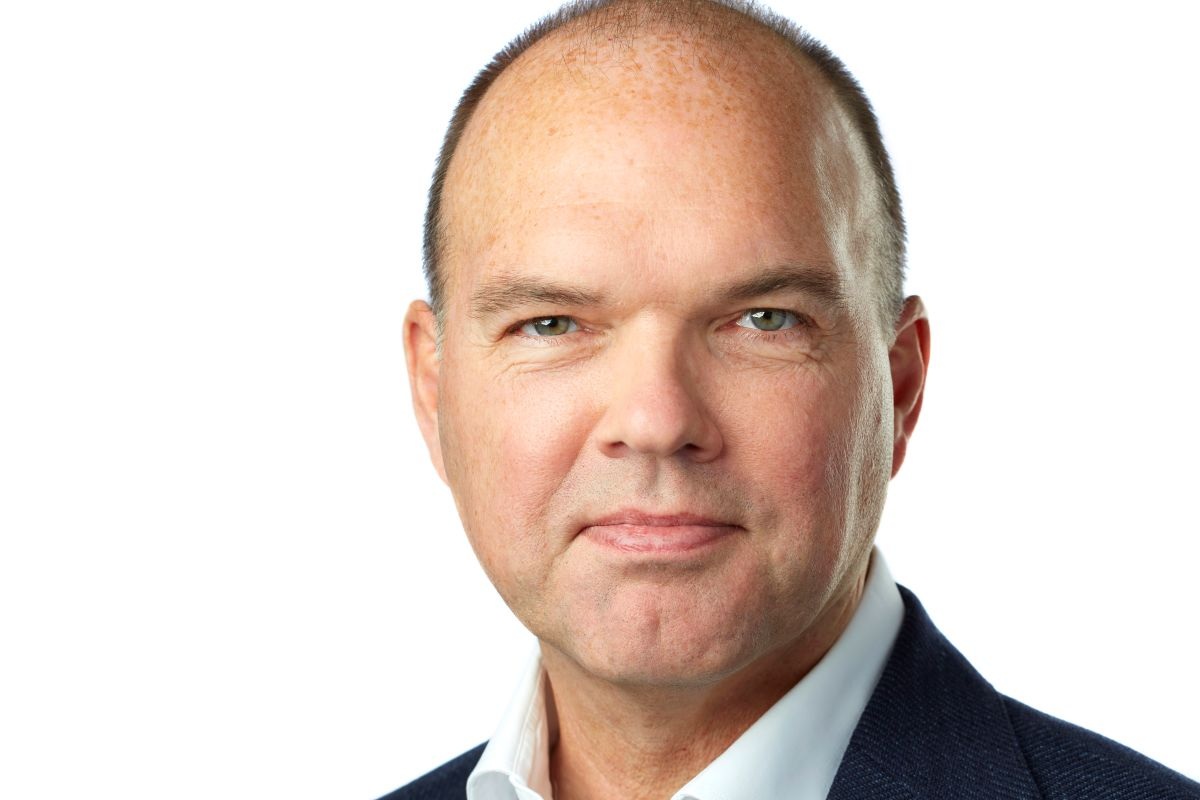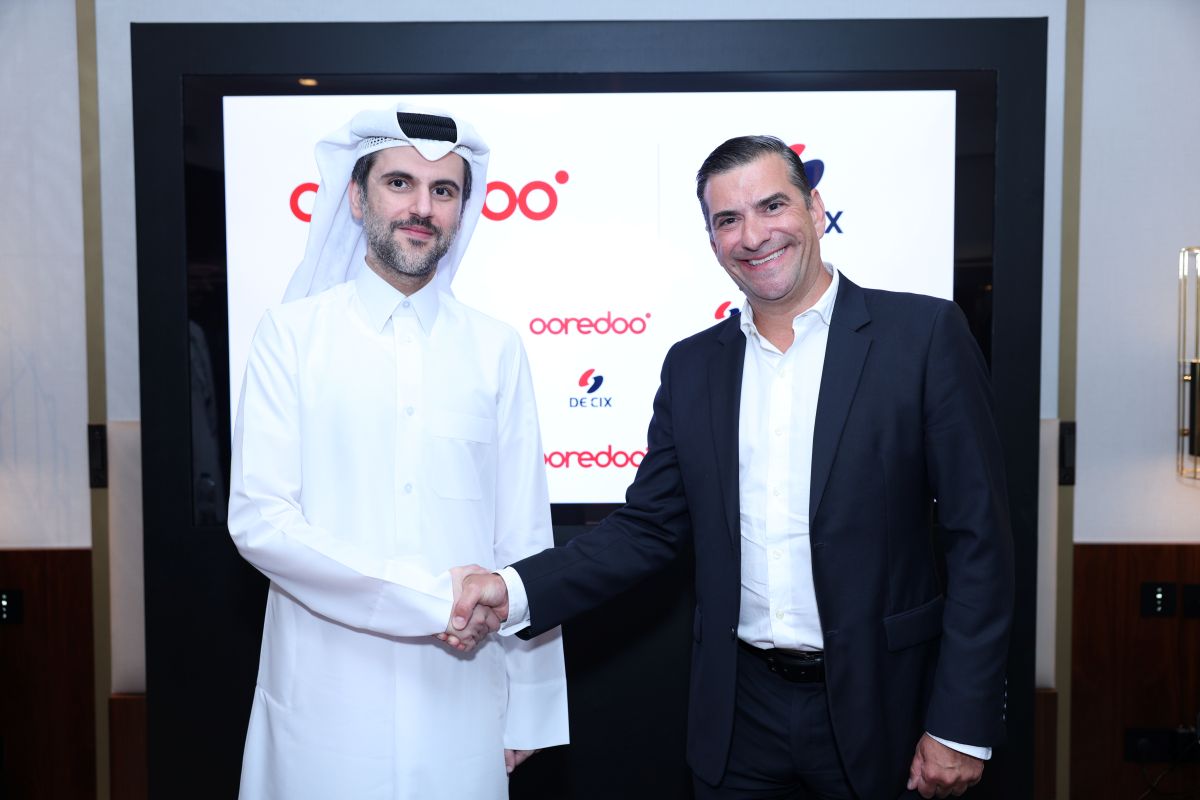Telecoms
Cloud
Networking
News
Telecoms
Nokia partners with atNorth to support cloud services in Finland
atNorth, a Nordic colocation, high-performance computing and AI service provider, has announced plans to support Nokia’s cloud infrastructure with a multi megawatt deployment at its FIN02 site in Finland (pictured above). The contract spans over 12 years and includes potential extensions totalling over 10MW.
Nokia, one of the world’s leading telecommunications and networking technology companies, is headquartered in Finland and has long utilised Finnish data centres, leveraging the country’s cool climate and renewable energy sources to ensure the sustainability of its workloads. In fact, the business was ranked as the most sustainable telecoms and communications company in the world earlier this year.
Nokia and atNorth have built a long-standing relationship through atNorth’s use of Nokia data centre switches that power its HPCaaS offering, which currently runs from its data centres in Iceland and Sweden.
Well versed in the evolving data centre landscape, Nokia was looking for a data centre partner that could accommodate its high-density infrastructure needs without compromising its environmental credentials. The business required capacity suitable for high-density workloads of more than 130kw per rack, available at speed and with the potential for future scalability.
Located in Espoo, Greater Helsinki, atNorth’s newest data centre, FIN02, runs on renewable energy and features robust power and liquid cooling capabilities. Built for scalability, its modular design supports high-performance workloads. A collaboration with Kesko Corporation enables waste heat recycling to heat a nearby store, further lowering its carbon footprint.
“atNorth was able to meet our complex technical requirements at speed without compromising on our sustainability goals,” says Marika Mentula, Vice President for Network Infrastructure North Europe at Nokia. “By helping support our cloud infrastructure at atNorth’s FIN02 data center, we can deliver high-performance infrastructure that supports our most demanding applications.”
Eyjólfur Magnús Kristinsson, CEO of atNorth, adds, “As the data centre industry continues to grow at record speed, it’s clear that businesses are increasingly seeking the full package - sustainable, secure, infrastructure that can scale rapidly. Our longstanding partnership with Nokia, rooted in the hardware demands of our HPCaaS offering and built on a shared commitment to sustainability, is a testament to that. It adds to a growing list of globally recognized companies that trust atNorth with their mission-critical data and rely on us to deliver best-in-class service.”
The news follows atNorth’s recent announcement of its heat reuse partnership with retail giant, Kesko Corporation at its FIN02 data centre in Finland. The business has two other metro sites near Helsinki, and a fourth ‘mega’ site - which is currently in development in Kouvola - is expected to be operational by the end of 2025.
For more from atNorth, click here.
Simon Rowley - 29 April 2025
Networking
News
Telecoms
Huber+Suhner unveils new lab automation solution
Telecommunications carriers can now step away from time-consuming manual testing and benefit from an automated lab landscape for their networks, thanks to a new advanced lab automation solution from Huber+Suhner featuring optical circuit switching and RF-over-Fibre (RFoF).
Replacing traditional coaxial interconnected and manually controlled labs, the innovation integrates fibre connectivity and optical circuit switching technologies to provide an automated, transparent and user-configurable fibre layer.
For transport and core network labs, an optical circuit switch allows for flexible connection and measurement of optical network components in a test environment. The POLATIS optical circuit switch, featuring patented DirectLight beam-steering technology, enables continuous testing of multiple devices remotely, eliminating the need for physical presence and manual re-patching. This not only reduces labour costs but also frees up time.
For RAN labs, RFoF modules can be deployed to convert signals from RAN radios into fibre optic signals which enables much greater transmission distances with significantly lower losses from Device Under Test (DUT) to test equipment. The optical circuit switching can then be utilised in the same way as with transport and core network labs. The high performance opto-electrical conversion ensures minimal impact on measurement results and provides bidirectionality for both the optical and the RF domains.
As a result, an automated fibre optic network layer for device testing can be configured or reconfigured in seconds rather than hours or days, allowing customers to meet challenging test cycle turnaround times.
“Carriers are under intense pressure to rapidly test and deliver enhanced network services, while validating new equipment,” says Claudia Bartholdi, Market Manager, Huber+Suhner. “The longer it takes to certify new equipment and services through manual operations, the further a business gets from increasing revenue and competitiveness. Through our end-to-end solution, we can ensure high reproducibility, traceability and increased efficiency, alongside a faster time to market.”
Regression, feature and interoperability testing are all key procedures for carriers. Regression testing ensures software releases do not impact the existing functionality of a network but may require thousands of individual tests that must be run in cascaded sequences. Carriers must also look to enhance network performance and user experience, which requires new features like network slicing, while ensuring any new equipment, elements or interfaces within a network function according to predefined standards and can coexist in a network.
The lab automation innovation for carriers enhances these procedures. For regression testing, it drastically reduces the time for test set-up and operation to introduce new software releases quickly and efficiently. It can also be implemented to allow agile feature testing, helping to verify that the new functionalities will work on an end-to-end basis before they are introduced into the live network.
For interoperability testing, the innovation simplifies the testing of virtual RANs, as well as open standard software and hardware, to ensure all network elements work together effectively.
“By automating test processes, labs can also share expensive equipment and reconfigure tests remotely and immediately,” Claudia continues. “Using readily available tools, resources can now be securely shared between labs dedicated to different elements of the network without conflict, quickening the testing process.”
For more from Huber+Suhner, click here.
Simon Rowley - 3 April 2025
Data
Internet
Networking
News
Telecoms
Broadband Forum launches trio of new open broadband projects
An improved user experience, including reduced latency and a wider choice of in-home applications, will be delivered to broadband consumers as the Broadband Forum launches three new projects.
The three new open broadband projects will provide open source software blueprints for application providers and Broadband Service Providers (BSPs) to follow. These will deliver a foundation for Artificial Intelligence (AI) and Machine Learning (ML) for network automation, additional tools for network latency and performance measurements, and on-demand connectivity for different applications.
“These new projects will play a key role in improving network performance measurement and monitoring and the end-user experience,” says Broadband Forum Technical Chair, Lincoln Lavoie. “Open source software is a crucial component in providing the blueprint for BSPs to follow and we invite interested companies to get involved.”
The new Open Broadband-CloudCO-Application Software Development Kit (OB-CAS), Open Broadband – Simple Two-Way Active Measurement Protocol (OB-STAMP), and Open Broadband – Subscriber Session Steering (OB-STEER) projects will bring together software developers and standards experts from the forum.
The projects will deliver open source reference implementations, which are examples of how Broadband Forum specifications can be implemented. They act as a starting point for application developers to base their designs on. In turn, those applications are available on platforms for BSPs to select and offer to their customers, shortening the path between the development of the specification to the first deployment of the technologies into the network.
“The development of open source software and open broadband standards are invaluable to the industry, laying the foundations for faster innovation through global collaboration,” says Broadband Forum CEO, Craig Thomas. “The Broadband Forum places the end-user experience at the forefront of all of our projects and is playing a crucial role in overcoming network issues.”
OB-CAS aims to simplify network monitoring and maintenance for BSPs, while also offering a wider selection of applications from various software vendors. Alongside this, network operations will be simplified and automated through existing Broadband Forum cloud standards that use AI and ML to improve the end-user experience.
OB-STAMP will build an easy-to-deploy component that simplifies network performance measurement between Customer Premises Equipment and IP Edge. The project will allow BSPs to proactively monitor their subscribers’ home networks to measure latency and, ultimately, avoid network failures. Four vendors have already signed up to join the efforts to reduce the cost and time associated with deploying infrastructure for measuring network latency.
Building on Broadband Forum’s upcoming technical report WT-474, OB-STEER will create a reference implementation of the Subscriber Session Steering architecture to deliver flexible, on-demand connectivity and simplify network management. Interoperability of Subscriber Session Steering is of high importance as it will be implemented in the access network equipment and edge equipment from various vendors.
Carly Weller - 5 March 2025
Data Centres
Networking
News
Telecoms
MXT Holdings improves data centre connectivity in Mexico
MXT Holdings (MXT), a telecommunications infrastructure company in Mexico that develops and operates neutral-host communication infrastructure assets, is deploying Ciena's coherent routing innovations - and in the process, taking proactive measures to handle escalating traffic demands placed on its network driven by 5G, cloud-based applications, and the evolving digital landscape.
MXT manages over 3,500km of long-haul and metropolitan fibre optic networks in Central and Southeast Mexico. Its network is deployed across key states, including Quintana Roo, Chiapas, and Tabasco. To improve connectivity for its customers and create a more adaptive network, MXT is utilising Ciena’s coherent routing across its metro and long-haul networks.
This upgrade will allow MXT to connect key links between Mexico City and Monterrey, creating a network that is significantly more resilient, reliable, and scalable. MXT will also be able to offer up to 400G connectivity options for data centres, high-performance computing networks, enterprises, and service provider applications.
Jorge Millones, COO, MXT, comments, “At MXT, we are committed to delivering connectivity that goes beyond our customers’ expectations. With Ciena’s coherent routing innovations, we are better able to support our customers’ digital experiences and offer more robust and reliable connectivity. Ciena’s technology allows us to optimise network performance by streamlining hardware components. This not only enables faster time to market, giving our customers a distinct advantage in today’s highly competitive environment, but also drives operational efficiency.”
This transformative network upgrade will not only improve the overall customer experience, but also allow MXT’s network to boost infrastructure efficiency and create a network that can seamlessly adapt to meet evolving bandwidth demands.
MXT’s network leverages Ciena’s coherent routing solution comprised of the 5164 Router and 8114 Coherent Aggregation Router with WaveLogic 5 Nano (WL5n) 400ZR pluggable transceivers running over Ciena’s Coherent ELS and 6500 open line systems. With Ciena’s coherent routing, MXT can deploy less hardware, saving capex and opex, while flexibly supporting a range of use cases, including data centre interconnect (DCI).
The multi-layer network will be managed by Ciena’s Navigator Network Control Suite (NCS), providing ease of deployment and management. Additionally, with Ciena’s PinPoint OTDR, MXT can use advanced analytics and software tools to monitor and identify potential trouble spots and accelerate repair times.
Simon Rowley - 18 February 2025
Networking
News
Telecoms
nLighten appoints Chair of the Board
As nLighten continues to expand its digital infrastructure platform across Europe, the company has announced the appointment of Nick Read as Chair of the Board for nLighten. With over 30 years of experience spanning five industry sectors, and a deep expertise in telecommunications and digital infrastructure, Nick will provide strategic guidance to support nLighten’s growth and innovation efforts in digital infrastructure.
Nick has spent more than 16 years operating at board level, holding leadership positions across global businesses in telecoms, infrastructure, and technology. He currently holds a portfolio of board positions focused on digital infrastructure across EMEA and the US, including serving as Senior Advisor to Global Infrastructure Partners (now part of BlackRock), Consultant to I Squared Capital, Chair of the Board with EXA infrastructure, and Non-Executive Director at Booking Holdings, Radius Global Infrastructure, and Oak Consortium.
Previously, Nick had a 22-year career at Vodafone Group, where he played a pivotal role in shaping the company’s global strategy. He served as Group CEO, and was a Board Member from 2014 to 2022, leading Vodafone through a period of major business transformation, network expansion, and operational evolution.
Before joining Vodafone, Nick held senior global finance positions at Miller Freeman Worldwide as Group CFO and at Federal Express Corporation for 10 years. A Fellow Chartered Management Accountant, Nick was awarded an Honorary Doctor of Business Administration in 2022. He has been a long-time advocate for diversity and inclusion, serving as a United Nations HeForShe champion and United Nations Broadband Commissioner.
At nLighten, Nick will leverage his extensive industry expertise to support the company’s strategic expansion plans, commercial growth, and operational excellence. His deep understanding of global telecom markets and their evolving needs will be instrumental in guiding nLighten’s leadership team as the company scales its European footprint.
“We are excited to welcome Nick as Chair to the nLighten Board,” says Harro Beusker, CEO and Founder of nLighten. “His leadership experience in telecoms and digital infrastructure, combined with his track record in business transformation, will be invaluable as we continue to grow and evolve our platform. We look forward to working with him.”
Commenting on his appointment, Nick Read states, “I am excited to join nLighten at such a pivotal time for the digital infrastructure industry. The increasing demand for edge computing and sustainable data centre solutions presents a unique opportunity, and nLighten is well-positioned to lead in this space. I look forward to collaborating with the team to drive nLighten’s continued innovation and growth.”
Founded in 2021, nLighten has rapidly grown to 34 data centres, serving over 1,000 customers with over 200 employees. As nLighten continues to scale across key European markets, the company says that the addition of experienced leaders like Nick Read reinforces its commitment to providing high-performance, sustainable infrastructure solutions for the digital economy.
For more from nLighten, click here.
Simon Rowley - 17 February 2025
Internet
Networking
News
Telecoms
Ooredoo and DE-CIX bring Internet Exchange to Qatar
Ooredoo, a Qatar-based telecommunications operator, in partnership with DE-CIX, a global operator of carrier-neutral Internet Exchanges (IX), has officially announced Doha IX powered by DE-CIX, Qatar’s first standalone commercial Internet Exchange (IX).
Leveraging DE-CIX’s global expertise, developed across nearly 60 locations worldwide, this initiative strengthens Qatar’s position as a regional digital hub by enhancing connectivity, reducing costs, and delivering exceptional customer experiences.
Doha IX will offer a secure, carrier-neutral platform that facilitates low-latency traffic exchange, improves network performance, and supports remote peering services. Businesses in Qatar and across the region will benefit from cost-effective, direct access to global and regional content providers, streamlining connectivity through a single port while significantly reducing traditional IP Transit costs.
Doha IX is built on DE-CIX’s cutting-edge interconnection infrastructure and Ooredoo’s state-of-the-art data centres. Supported by both partners’ established relationships with global content providers and networks, these critical assets ensure seamless and efficient traffic exchange, reducing latency, optimising network performance, and creating a robust Internet Exchange ecosystem in Qatar.
“We are proud to introduce Doha IX, which represents a significant step in upgrading Qatar’s digital infrastructure,” says Thani Ali Al Malki, Chief Business Officer at Ooredoo Qatar. “Doha IX delivers faster, more reliable connectivity while reducing operational costs for businesses and driving innovation across various industries, aligning with the goals of Qatar’s National Vision 2030 and advancing our digital transformation initiatives.”
Ivo Ivanov (pictured above, right), CEO of DE-CIX, adds, “With Doha IX powered by DE-CIX, we are bringing DE-CIX’s global expertise to Qatar, enabling businesses and networks to benefit from superior interconnection services. Doha IX is the ideal place for international networks interested in reaching this important Middle Eastern market. The new IX, established through the partnership between DE-CIX and Ooredoo, will unleash the potential of the country’s digital economy by providing better performance and user experience of content and applications, and affordable and high-quality Internet access for enterprises and individuals. This partnership marks an important milestone in strengthening regional connectivity and creating an advanced digital ecosystem that supports economic growth and innovation in the GCC for the amazing digital decades ahead of us.”
DE-CIX is an established name in the Middle East, with a proven track record of developing healthy IXs and vibrant interconnection ecosystems. Doha IX, which will be built and operated under the DE-CIX as a Service (DaaS) model, is the sixth IX operated by DE-CIX in the region.
Through this collaboration, Ooredoo and DE-CIX are setting the foundation for advanced interconnection in the region. Together, they support Qatar’s digital transformation goals and are seeking to position the country as a leader in the global digital economy, aligning with Qatar’s National Vision 2030.
For more from DE-CIX, click here.
Simon Rowley - 10 February 2025
Cabling
Events
Networking
News
Telecoms
Exclusive interview with Submarine Networks EMEA organisers
Ahead of the upcoming Submarine Networks EMEA 2025 event, taking place on 18-19 February at the Business Design Centre in London, Simon Rowley, Editor of DCNN, speaks with Harry Baldock, Editor of Total Telecom - the event's organiser - about what visitors can expect from this year's two-day show.
DCNN: For our readers who may not be familiar with Submarine Networks EMEA, what can you tell them about the event?
Harry: Submarine Networks EMEA is the largest annual subsea connectivity event, bringing together the over 1,000 senior leaders from across the industry for two days of networking and vibrant conference sessions. The event takes place at the Business Design Centre in London and attracts attendees from all over the world.
Total Telecom has been hosting this event since 2018, during which time it’s gone from strength to strength, becoming a mainstay for the subsea community every year.
DCNN: What are some of the biggest trends impacting subsea connectivity at present, and in what ways will these be reflected at the show?
Harry: Personally, I think there are three big themes we’re seeing in the submarine cable space right now: security, geopolitics, and the recent boom in AI-powered data centre investment. Increasing security concerns, driven by the unstable global situation, are leading to tighter regulation and therefore more hurdles to be overcome when connecting cables to certain countries. This is leading to costly delays in planning and deployment – in some cases, sections of cable have already been built, but regulatory changes have left their owners unable to activate them.
On the other hand, the booming data centre market is presenting many new opportunities for the subsea industry. All of these data centres will need global connectivity and their deployment is triggering a new wave of cable deployment, particularly in previously underserved areas.
Other important topics include cable sustainability, maintenance, and recycling; cable deployment and repair ships; SMART cables (built with sensors to capture scientific data); subsea regulation; and training the next generation of professionals in this often-underappreciated industry.
DCNN: How many exhibitors will be in attendance at this year's event, and what products or innovations will be showcased?
Harry: There will be over 50 exhibitors at the show this year, showing off a wide variety of new projects and technologies.
The core of the exhibitors, of course, are those showing cable system-related solutions – from landing station technology to the latest optical technologies. But there are many more players that play a role in a successful subsea cable project – for example, cable builders and operators, data centre operators, cable deployment experts, optical networking solutions providers, public sector officials, and national regulators. All of these will feature representation on the show floor at Submarine Networks EMEA.
DCNN: The event will also include a jam-packed conference programme. What's in store for visitors this year, and what are expected to be among the highlights of these sessions?
Harry: The telecoms and tech industries have become ever more interwoven in recent years, and this is clearly reflected in our conference agenda, which touches on everything from cable investment strategies to integrating sensing technologies. Our morning keynote sessions are always a major highlight; this year, our Day 1 keynote focuses on the privatisation of the submarine cable industry and the role of the hyperscalers, while Day 2’s will focus on the rapidly expanding data centre environment.
On a personal level, as a journalist, I really enjoy the ‘News in Brief’ sessions – 10-minute updates on various cable projects around the world. They are always crammed with information. They also tend to include interesting anecdotes about overcoming challenges along the way, whether its decommissioning sea mines in the North Sea or having engineers canoe around the Norwegian fjords as part of the cable planning process!
Lastly, a major goal for the event has always been to shed light on this niche industry as a career path and to help nurture the next generation of subsea professionals. Our Junior Top Dogs networking event, taking place on Day 2, is specifically designed to give students and other newcomers to the industry the opportunity to talk directly with industry veterans.
You can check out our full agenda by clicking here.
DCNN: Data centres are listed among the nine key themes that Submarine Networks EMEA will tackle. Could you expand on this notion and provide insight as to what visitors can expect with regards to this?
Harry: As I’m sure your readers are aware, the data centre industry has been booming, with the hyperscalers pledging to invest billions of dollars in new data centre deployments in the coming years. Those same hyperscalers – like Meta, Google, and Microsoft – are also the key movers and shakers of the submarine cable industry, typically playing a leading role in the consortiums that build the submarine cables.
The relationship between submarine cables and data centres is quite fundamental. More data centres being deployed globally will have major implications for the type and capacity of new cable systems deployed, and where these systems will interconnect with terrestrial networks.
The Day 2 opening keynote focuses on this topic in detail, asking how the AI-driven data centre surge is impacting the subsea sector and what the two industries can learn from each other.
DCNN: What are some of the biggest challenges in the subsea connectivity sector in 2025?
Harry: As mentioned, cable security is a big challenge. We’ve seen lots of cable damage in key geopolitical hotspots in recent years – particularly the Red Sea, the Baltic Sea, and the waters around Taiwan – and, while accidental damage to cables happens every year, deliberate sabotage is suspected in a number of cases.
Physically monitoring and defending such massive cables is a technical challenge of huge scope and financial cost, but one that the industry is under increasing pressure to solve.
These security fears are, in turn, leaching into the regulatory landscape, which is at risk of becoming more intrusive and potentially obstructive to subsea projects. This is particularly the case in the US, where the Federal Communications Commission is currently reworking its submarine cable regulations for the first time since 2001! Just this month we have seen the UK government take steps in a similar direction, launching a subsea cable security enquiry this year and seeking to identify emerging threats in this space.
As a result, submarine cable projects are likely to be more closely regulated, causing delays and additional expenses. In some cases, cable systems could be forced to circumvent some countries or bodies of water entirely.
But the geopolitical uncertainty of the modern world is not all doom and gloom for the submarine cable industry. With national governments growing increasingly picky around how their international data is transported, opportunities to build new cables to meet these needs are beginning to arise. Greater submarine cable diversity means more choice for customers and reduces reliance on individual cables.
DCNN: Is AI having a big impact on this sector, and if so, will this be a big theme throughout the event?
Harry: I would describe AI’s effect on the sector as indirect but significant. As mentioned, AI is spurring a major investment in specialised data centres and seeing global data usage estimates increase massively. The submarine cable industry will have to adapt to this changing environment, though modern cables should be able to handle the predicted increase in data transport.
Perhaps more interesting, the cable owners themselves are making increasing use of AI when planning and operating these systems, particularly regarding automation. This can deliver some huge cost-savings, enhance network monitoring, and support predictive maintenance.
DCNN: What are the show's organisers most excited about heading into this year's exhibition?
Harry: We’re thrilled to once again be at the heart of such a vibrant industry! We’re very lucky that the submarine cable industry is extremely collaborative by nature, and so great conversations are never far away. We’re looking forward to providing a forum for these discussions and helping the community tackle some of the biggest challenges in the sector today.
DCNN: Is there anything else you'd like DCNN readers to know about?
Harry: There is an oft-quoted figure in the industry that submarine cables carry over 95% of global internet traffic, but the vast majority of people do not even realise they exist. So, my message to readers would be: don’t forget about the submarine cable industry! It’s a huge, unseen part of our global digital fabric and becomes more diverse and broader in scope every year.
Whether you’re dipping your toes into the submarine cable industry for the first time or you’re an industry veteran looking for a deep dive, Submarine Networks EMEA will put you at the heart of the industry.
Submarine Networks EMEA will be taking place on 18–19 February at the Business Design Centre in London. If you’d like more information or want to get involved in Submarine Networks EMEA, please contact the event's Project Director, Laura O’Reilly, at laura.oreilly@totaltele.com.
Simon Rowley - 31 January 2025
Networking
News
Telecoms
New 5G network to spark innovation at German University
A new 5G network backbone for more advanced research initiatives and immersive learning platforms has been deployed at Rosenheim Technical University of Applied Sciences (TH Rosenheim) in Germany, thanks to a collaboration between Slovenia’s Kontron and Mugler SE.
Slovenia’s Kontron’s 5G Mobile Private Network (MPN), integrated by network systems integrator and telecommunications solutions supplier, Mugler SE, will provide greater speeds, low latency, and increased capacity for more than 7,500 students at the university’s proto_lab research facility.
“At Kontron, we are proud to be part of a project that not only advances cutting-edge research, but also creates invaluable learning opportunities for the next generation of innovators,” says Janez Öri, Slovenia’s Kontron Executive Director of Communications Solutions. “The deployment of our 5G MPN underscores our commitment to empowering industries and academic institutions with reliable, high-performance connectivity solutions that drive transformation and progress.
“The collaboration with TH Rosenheim and Mugler SE serves as a blueprint for the future, demonstrating how academia and industry can work together to empower education through technology.”
The network will enable a seamless integration of AI algorithms and real-time applications at network edge and in the cloud. This aligns with the core aim of proto_lab's ground-breaking research projects under the guidance of Prof. Dr.-Ing. Noah Klarmann, Research Professor in AI for Technical Systems and Co-Director of proto_lab. It will also equip students with the skills to innovate in the increasingly digitalised world.
“A reliable network can offer improved mobility and flexibility to cater for people and assets on the move in ever-changing production and logistics environments,” comments TH Rosenheim proto_lab Initiator, Co-Founder, and Director of the Research and Development Platform Prof. Dr.-Ing. Oliver Kramer. “Individualisation caters for customers increasingly asking for personalised technology solutions to meet their unique needs and is providing them with a critical competitive edge over their rivals. Our 5G campus network also provides the perfect foundation for the implementation and further development of our R&D projects in the proto_lab.”
With Slovenia’s Kontron’s 5G MPN, industries and enterprises can improve their operations, thanks to enhanced automation, security, and indoor and outdoor connectivity. The network supports various use cases, including asset tracking, automated robots and AVGs, flexible workspaces, real-time process automation and voice and video communications.
“The network deployment is the starting point for our comprehensive four-year partnership, during which time, various industry-relevant use cases will be tested,” adds Mugler SE Director Local Networks, Dr. Markus Dod. “At Mugler SE, we focus on providing reliable and forward-looking telecommunications solutions. This partnership with Kontron and TH Rosenheim highlights how 5G technology, combined with practical integration expertise, can drive meaningful progress. Our aim is to demonstrate how customised 5G networks can effectively support both industry and academia in advancing connectivity and automation.”
For more from Kontron, click here.
Simon Rowley - 29 January 2025
Networking
News
Telecoms
Telkomsel expands 5G network across Greater Jakarta area
Telkomsel, a provider of digital telecommunications services, has expanded its 5G network (Hyper 5G) in the Greater Jakarta area (Jabodetabek). With the support of Huawei, this initiative is undertaken to welcome the Christmas and New Year festivities, ensuring the community enjoys the best digital experience during the season.
Telkomsel’s Hyper 5G coverage now includes several key routes in and around Jakarta, from Soekarno-Hatta to Halim Perdanakusuma airports, the master-planned areas of Pantai Indah Kapuk 1 and 2, to business and government hubs spanning from Pondok Indah to the National Monument (Monas). In the near future, Telkomsel plans to expand its 5G network incrementally, strategically, and systematically to other prime locations across Indonesia.
Telkomsel's 5G technology delivers internet speeds up to four times faster than 4G, providing greater reliability, the ability to connect more devices, and low latency to support emerging technologies and innovations.
Since its commercial launch in 2021, Telkomsel's Hyper 5G has become the most extensive and advanced network in Indonesia, with over 1,400 5G base transceiver stations (BTS) spread across 56 cities and regencies, driving progress and supporting the country’s digital transformation.
Telkomsel’s Chief Technology Officer, Indra Mardiatna, states, “As the epicentre of economic activity, governance, and a national progress barometer, this region has significant 5G smartphone penetration, a high number of international roamers, growing 4G/LTE users, and increasing demand for high-speed data. With the Hyper 5G network, we not only deliver ultra-fast connectivity and low latency, but also serve as a catalyst for digital transformation, opening opportunities for progress in every aspect of life as we strive toward the vision of a Golden Indonesia 2045.”
Telkomsel is also integrating an end-to-end Hyper AI approach powered by artificial intelligence (AI) to improve service efficiency and quality. This technology ensures faster responses to network disruptions and enables automated network management through an Autonomous Network framework.
“Through Hyper AI, Telkomsel provides optimal service quality in various situations, ensuring the best customer experience anytime, anywhere, including at crowded points during Christmas and New Year and strategic Hyper 5G locations,” adds Indra.
The low latency of Hyper 5G further supports the Hyper AI approach, such as in the implementation of Telkomsel’s AI-Based Customer Care Virtual Assistance services. The Veronika Virtual Assistant (B2C) Internal and Ted Virtual Account Manager (B2B), integrated with the AI Service Operations Center, enable quick and effective responses to customer needs, delivering innovative and superior service experiences in the 5G era.
During the festive period, Telkomsel anticipates a 14.8% increase in data traffic, with total payloads expected to reach 1,981 petabytes. Comprehensive infrastructure optimisation for both 4G/LTE and 5G networks, supported by thorough network testing across key routes and strategic locations, has been implemented to ensure customer convenience in accessing digital services.
Indra concludes, “As a leading digital telecommunications service provider, Telkomsel is committed to spreading optimism and positive energy to the community. By optimising the readiness of connectivity, services, and innovative solutions, Telkomsel strives to ensure every customer enjoys Christmas and New Year moments with ease, comfort, and joy.”
Simon Rowley - 10 December 2024
Networking
News
Telecoms
Wi-Fi
DSA details economic value of 6 GHz spectrum band
The full allocation of the 6 GHz band to Wi-Fi delivers the highest economic impact for India and enables the development of innovative products and services, the Dynamic Spectrum Alliance (DSA) announced at the fourth Indian Spectrum Management Conference.
The economic value for allocating the full 6 GHz for unlicenced use would amount to approximately $4,030 billion. This includes $3,544 billion in GDP contributions, $329 billion in consumer surplus, and $158 billion in producer surplus between now and 2034.
“The Department of Telecommunications (DoT) for India is currently considering different approaches to the 6 GHz band for licence-exempt use,” says DSA President, Martha Suarez. “The findings provided by the Telecom Advisory Services demonstrate that a full allocation for Wi-Fi is the best option for boosting the Indian economy and driving the country’s digital transformation. Furthermore, Wi-Fi can coexist with the satellites services that currently operate in the 6GHz band in India.”
A number of approaches have been proposed to the DoT, including the splitting of the 6 GHz band between Wi-Fi and International Mobile Telecommunications (IMT). In this scenario, Wi-Fi would be allocated the lower 500 MHz band, and IMT the upper 700 MHz band. The allocation of 1100 MHz to Wi-Fi, and 100 MHz to IMT, has also been suggested.
When comparing these alternatives, the full allocation to Wi-Fi would deliver $858 billion more than the second option (and $46 billion higher than the third option) towards the Indian economy. Limiting the allocation of Wi-Fi to just 500 MHz would mean a restriction of indoor Wi-Fi speeds by 50%, while more than half of IoT devices would be limited in their indoor and outdoor access. 81.82% of augmented and virtual reality (AR/VR) devices used in indoor environments would also be limited in terms of their ability to operate.
“Innovative technologies such as Wi-Fi 6e and 7, in the 6 GHz band, are critical to enhance government programs such as Digital India and Make in India,” comments President of the Itu-Apt Foundation of India, Bharat Bhatia. He urged India's Minister of Communications to urgently license the lower 6 GHz band while studies on the upper band are ongoing.
“There’s one further consideration to be made,” adds President of the Telecom Advisory Services, Dr. Raul Katz. “Assuming that the World Radio Conference decides to allocate the upper 6 GHz to IMT during WRC-27, then equipment and devices for wideband mobile networks will need to be designed, tested and deployed, and it would take another two years to reach a useful deployment of service. On the other hand, Wi-Fi technology is already commonplace and can be deployed immediately with no additional requirements.”
The full Assessment of the Economic Value of the 6 GHz Spectrum Band in India report, developed by Telecom Advisory Services and commissioned by the DSA, can be found on the DSA website by clicking here.
Simon Rowley - 8 November 2024

Head office & Accounts:
Suite 14, 6-8 Revenge Road, Lordswood
Kent ME5 8UD
T: +44 (0)1634 673163
F: +44 (0)1634 673173









